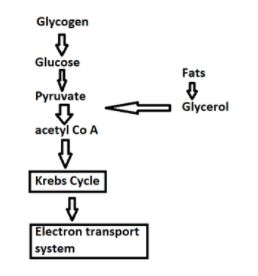
Link between glycolysis, Krebs cycle and beta-oxidation of fatty acid is
A) Pyruvic acid
B) Acetyl CoA
C) Acetaldehyde
D) Citric acid
Answer
500.1k+ views
Hint: This molecule is involved in the metabolism of various substrates such as proteins, carbohydrates and fats. The acetyl group of this molecule is transferred to the krebs cycle for oxidation. Thus, it helps production of energy. The main substrate for the synthesis of this molecule is glucose.
Complete answer:
All organisms need energy to survive. This energy comes from the breakdown of complex substances into simpler ones. The glucose is the main substrate which is used in the respiration process. However, other substrates are also used during respiration.
Before entering into the respiratory pathway, the carbohydrates are first converted into glucose. It then enters the respiratory pathway and undergoes glycolysis. The end product of glycolysis is pyruvic acid. By oxidative decarboxylation, the pyruvic acid is converted into acetyl CoA. This reaction takes place in the presence of an enzyme called pyruvate dehydrogenase. The acetyl CoA formed is then used for the formation of ATP in the Krebs cycle.
Similarly, before entering the respiratory pathway, the fats are broken down to form fatty acids and glycerol. The fatty acids are then converted into acetyl CoA. This acetyl CoA then enters the respiratory pathway and enters the Krebs cycle to form ATP.
- Pyruvic acid/pyruvate is the byproduct of glycolysis.
- Citric Acid is formed as a result of the reaction of Acetyl CoA and oxaloacetate. It is the first stable product of the Kreb cycle.
- Acetaldehyde- it is the final electron acceptor in alcoholic fermentation.
The diagram representing the cellular respiration is as follows-

Thus from the discussion and the diagram the answer of the above question is acetyl CoA. All the substrates are first converted into acetyl CoA before entering the krebs cycle. Hence, it is the common link between glycolysis, krebs cycle and beta-oxidation of fatty acids.
Therefore the correct answer is option ‘B’.
Note: The steps of glycolysis are also called EMP pathways because it was given by three scientists namely Gustav Embden, Otto Meyerhof and J. Parnas. Oxygen is not used in this process. This process occurs in both aerobic and anaerobic organisms. Glycolysis process takes place in the cytoplasm of the cell during which the partial oxidation of glucose results in formation of two molecules of pyruvic acid. In aerobic organisms, the pyruvic acid enters the krebs cycle while in anaerobic organisms, ethanol or lactic acid is formed from pyruvic acid.
Complete answer:
All organisms need energy to survive. This energy comes from the breakdown of complex substances into simpler ones. The glucose is the main substrate which is used in the respiration process. However, other substrates are also used during respiration.
Before entering into the respiratory pathway, the carbohydrates are first converted into glucose. It then enters the respiratory pathway and undergoes glycolysis. The end product of glycolysis is pyruvic acid. By oxidative decarboxylation, the pyruvic acid is converted into acetyl CoA. This reaction takes place in the presence of an enzyme called pyruvate dehydrogenase. The acetyl CoA formed is then used for the formation of ATP in the Krebs cycle.
Similarly, before entering the respiratory pathway, the fats are broken down to form fatty acids and glycerol. The fatty acids are then converted into acetyl CoA. This acetyl CoA then enters the respiratory pathway and enters the Krebs cycle to form ATP.
- Pyruvic acid/pyruvate is the byproduct of glycolysis.
- Citric Acid is formed as a result of the reaction of Acetyl CoA and oxaloacetate. It is the first stable product of the Kreb cycle.
- Acetaldehyde- it is the final electron acceptor in alcoholic fermentation.
The diagram representing the cellular respiration is as follows-

Thus from the discussion and the diagram the answer of the above question is acetyl CoA. All the substrates are first converted into acetyl CoA before entering the krebs cycle. Hence, it is the common link between glycolysis, krebs cycle and beta-oxidation of fatty acids.
Therefore the correct answer is option ‘B’.
Note: The steps of glycolysis are also called EMP pathways because it was given by three scientists namely Gustav Embden, Otto Meyerhof and J. Parnas. Oxygen is not used in this process. This process occurs in both aerobic and anaerobic organisms. Glycolysis process takes place in the cytoplasm of the cell during which the partial oxidation of glucose results in formation of two molecules of pyruvic acid. In aerobic organisms, the pyruvic acid enters the krebs cycle while in anaerobic organisms, ethanol or lactic acid is formed from pyruvic acid.
Recently Updated Pages
Why are manures considered better than fertilizers class 11 biology CBSE

Find the coordinates of the midpoint of the line segment class 11 maths CBSE

Distinguish between static friction limiting friction class 11 physics CBSE

The Chairman of the constituent Assembly was A Jawaharlal class 11 social science CBSE

The first National Commission on Labour NCL submitted class 11 social science CBSE

Number of all subshell of n + l 7 is A 4 B 5 C 6 D class 11 chemistry CBSE

Trending doubts
Differentiate between an exothermic and an endothermic class 11 chemistry CBSE

10 examples of friction in our daily life

One Metric ton is equal to kg A 10000 B 1000 C 100 class 11 physics CBSE

Difference Between Prokaryotic Cells and Eukaryotic Cells

1 Quintal is equal to a 110 kg b 10 kg c 100kg d 1000 class 11 physics CBSE

State the laws of reflection of light




